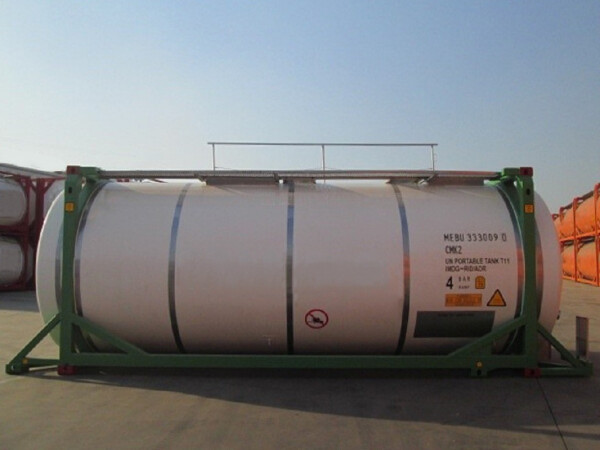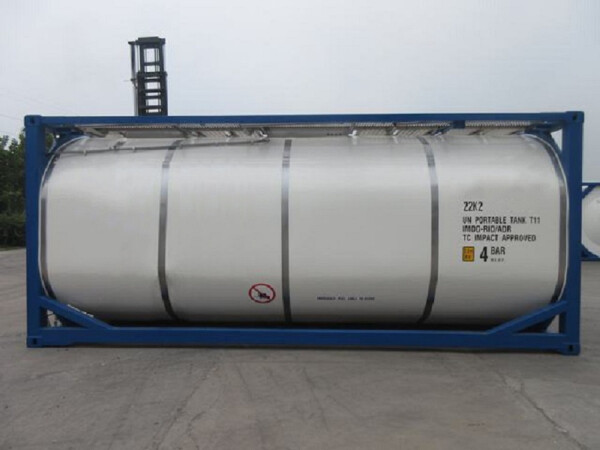
Specifications
About the 20ft tank-in-box
Introducing our custom-built Tank-in-Box, the ultimate alternative to a regular tank with spilltainer. This innovative container boasts a built-in reservoir that provides unparalleled protection, ensuring zero spillage of liquid even in the highly unlikely event of leakage. Designed to accommodate practically all NON ADR (non-hazardous) products, this versatile solution offers superior safety and convenience.
Equipped with a ground-operated filling connection, our Tank-in-Box allows for effortless loading and discharging, maintaining optimal inner pressure during the process. The ground-operated air inlet enables easy opening and closing from ground level. Our tank design includes a 500 mm manhole and a PV valve.
Additionally, our Tank-in-Box features a handy level indicator, providing real-time visibility of the tank's fill level. This user-friendly feature ensures efficient monitoring and precise control of your cargo.
Experience the cutting-edge technology and exceptional safety of our custom-built Tank-in-Box, the ideal solution for your non-hazardous liquid transportation needs.
Certifications
At Meeberg ISO Tanks & Containers, we ensure all our new & second hand tank containers are delivered with certifications from leading organizations such as Lloyd's Register (LR), American Bureau of Shipping (ABS), Bureau Veritas (BV) and SGS. This guarantees the highest standards of safety, quality, and reliability for your operations.
We offer the following types of certifications for our clients:
2.5-Year Test for ISO Tank Containers
The 2.5-year test, also known as the intermediate inspection, is a crucial part of maintaining ISO tank containers. Conducted halfway through the 5-year certification period, this test ensures that the tank remains in safe and operable condition.Key aspects of the 2.5-year test include:
Visual Inspection: A thorough visual check of the tank's exterior and interior surfaces to identify any signs of wear, corrosion, or damage.
Leak Test: Conducting a leak test to ensure the tank's integrity and that there are no leaks that could compromise safety.
Valve and Gasket Checks: Inspecting all valves and gaskets for functionality and integrity, replacing any that are worn or damaged.
Structural Integrity Assessment: Verifying that the frame and overall structure of the tank meet the required safety standards.
5-Year Test for ISO Tank Containers
This test is more extensive than the intermediate 2.5-year test and involves a detailed assessment of the tank's condition and performance.Key aspects of the 5-year test include:
Internal and External Inspection: A thorough examination of both the interior and exterior surfaces of the tank to identify any corrosion, wear, or damage that could affect the tank’s integrity.
Hydrostatic Pressure Test: This test involves filling the tank with water and pressurizing it to check for leaks and ensure the tank can withstand its maximum working pressure without any issues.
Ultrasonic Thickness Testing: Measures wall thickness to ensure structural integrity.
Valve and Fitting Inspection: Checking all valves, fittings, and seals to ensure they are in good working condition.
Frame and Structural Assessment: Verifies compliance with ISO and CSC standards.
Documentation and Certification: Updating the tank’s certification to reflect that it has passed the 5-year test, ensuring it is compliant with relevant international standards such as IMDG, ADR, RID, and CFR 49.
CSC Test for ISO Tank Containers
The CSC (International Convention for Safe Containers) test ensures ISO tank containers meet international safety standards for transport. Key aspects include:
Structural Integrity Inspection: Checking the frame and structural components for strength and stability.
Safety and Security Checks: Ensuring all locking mechanisms and securing devices are functional.
Identification and Marking Verification: Confirming the presence and legibility of the CSC plate and other required labels.
Dimensional Accuracy: Ensuring the container meets ISO dimensional standards.
Damage and Wear Assessment: Identifying any signs of damage or corrosion.
Maintenance Record Review: Checking that maintenance and previous inspections are documented.










